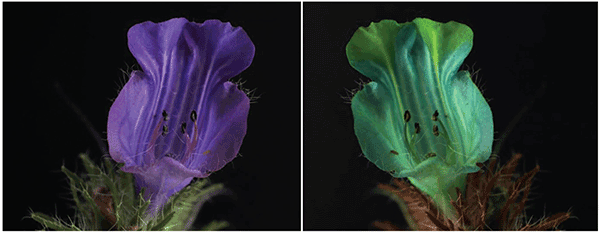Knowing how animals see the world is helping scientists better understand the environment and the ways animals live and survive. A new camera technology, developed at the University of Exeter in England, now allows humans to view the world through an animal’s eyes.
The new software suite, which converts digital photos to animal vision, is especially useful for studying animal and plant signaling, camouflage and predation. It has been used by the university’s sensory ecology group in a variety of study areas, including color change in green shore crabs and camouflage that protects bird eggs from potential predators. Sensory ecology, a relatively new field, focuses on the information animals obtain from the environment and how they acquire, process and respond to that information.
Color vision varies among animal species and even within a species. Humans and Old World monkeys, for example, have eyes generally sensitive to the three primary colors — red, green and blue — while other mammals are only sensitive to blue and yellow.

The image on the left of two Tenerife lizards is in human-visible colors. The male at the top, though more colorful than the female, is still fairly well-camouflaged. However, as highlighted in the false-color UV image on the right, the dusky blue/gray patches on the male’s cheek and bars on his flank are much more conspicuous to the female lizard (who sees in the UV) than to the human eye. This demonstrates how colors can be used as private signals in some species where evolutionary pressures for sexual signaling compete with the evasion of predators, according to researchers at the University of Exeter. Courtesy of Jolyon Troscianko.
The software enables a perspective of the world quite different from that of humans; most birds, reptiles, amphibians and many insects have eyes that are sensitive to four or more colors. Many of these creatures can also see into the UV range, a world invisible to humans without the use of full-spectrum cameras. For one example, when viewed in the UV spectrum, flowers often look more striking, apparently as a signal to attract pollinators, such as bees, that see in the UV range. The UV spectrum also is important for sexually selective species that use colorful physical displays to attract mates.
Scientists studying such species measure UV to understand how these animals view the world.
“Digital cameras are powerful tools for measuring colors and patterns in nature, but until now, it has been surprisingly difficult to use digital photos to make accurate and reliable measurements of color. Our software allows us to calibrate images and convert them to animal vision, so that we can measur


The flowers of Echium angustifolium are seen in human vision (left) and honey bee vision (right). To humans, the flowers are purple. Honey bees see two UV-absorbent patches at the top of the flower.
The software suite of image calibration and analysis tools is designed for objectively measuring reflectance, color and pattern. It generates images that are linear with respect to radiance from the RAW files of a variety of digital camera brands. It can combine image channels from multispectral cameras, including UV photographs, the authors say in their work, published in Methods in Ecology and Evolution (doi: 10.1111/2041-210x.12439).
Using a camera converted to full-spectrum sensitivity, one photograph taken through a visible-pass filter can be combined by the software with a second photo taken through a UV-pass filter. The software then generates functions to show the image through an animal’s eyes.
The suite of tools allows researchers to calibrate their images, incorporate multiple layers from visible and UV channels, convert to animal color spaces, and measure images. It eliminates some manual aspects, including complex programming and calculating.
Available for download at www.jolyon.co.uk, the free software includes specific data on camera settings for commonly studied animals, such as peafowl, honey bees, ferrets and some fish.
“We hope that other scientists will use this open access software to help with their digital image analysis,” Troscianko said.